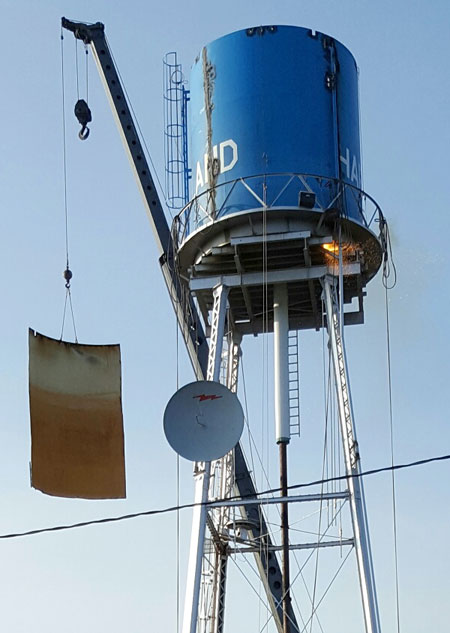Historic water tower disassembled

GOING, GOING, GONE — Workers needed only hours to disassemble Hartland’s historic water tower as crowds of spectators gathered to watch. (Photo by Nancy Toot)
By RODNEY HATLE
Contributing Writer
Down and away in one day, the last in August.
The very old and old-fashioned Hartland water tower, centered in town for more than 100 years, has been replaced by the new model two blocks south.
The new so slim and winsome.
The old one once so handsome.
The original designed for one village.
The current designed for two towns exactly six miles apart, Hartland and Freeborn. Their combined population is about 600.
In the 21st century such a project is called “A wave of the future.”
In the 20th century it was deemed an improvement over the 19th century.
While this water tower was razed in a day, spectators wondered how many were required to raise it. That was near 1900.
With increasing daylight, a Midwestern-based crew, said to be Maguire Iron of Michigan, arrived for an hour of preparation. By 6 o’clock, workers had large cutting torches in their hands and fuel containers on their backs. All were outfitted almost as space travellers, wearing protective clothing from the tips of their crowned hardhats to the soles of their sturdy boots.
Two or three were soon up the ladder. A growing number of townspeople gathered to see them against a blue sky cutting the bluer tank into four sections.
Red sparks flashed in bunches out from clouds of white heat.
A huge crane lifted each section separately, moving it to one side and expertly placing it where a ground crew of half a dozen sliced it smaller. A heavy-duty skid-loader moved in for the take and swung everything into a long Pooley Scrap Iron and Recycling truck bed.
For entertainment as history, points of observation around town included one group in an alley to the north. They brought chairs. Some of them had been seated early enough to get pictures of HARTLAND in white lettering on royal blue being torched into quarter sections.
More and more sparks of red hot flew in streaks and fell into the area circled with yellow tape: CAUTION – DO NOT ENTER.
It was perfectly obvious as to why. Fiery sparks may dissipate before hitting the ground 80 to 100 feet below. But more dangerous were the huge sections of silver legs and dangling supports.
The coordinated crew made it look easy.
On the south, townspeople sat on their decks and patios. Some were recording the activity on our most modern devices.
Wanderers came up the west streets to this day’s entertainment.
History was being made, seemingly in the most casual way.
A few more hours found observers in the north alley changing shifts. A new group of locals was joined by a family from Beaver Lake cabins.
Along Broadway Street on the east, which is Hartland’s thoroughfare, were sidewalk superintendents. One, with business papers in hand, paused for a few words with a fellow citizen whose eyes seldom veered off the upper action.
With his cane in hand, a man slowed to a stop on his way for the day’s mail. In a moment of reminiscence he mentioned standing on his head up there.
What?
Four youths old enough to know better, it was said, but adventurous. It was 1944. It was the other tank, wood with maybe a flatter top.
One of the four, it seems, commenced to singing in the twilight and that, it seems, alerted someone on the ground. When they descended, the local cop was there for arresting. One fellow had climbed down sooner and thus escaped the fines of $30 each. “A month’s salary” at the time.
It was also the time of World War II, and that was the next stop for most youths coming of age in that decade. Monthly pay may have been only a little better in the U.S. military. Not to mention a different kind of danger.
Modern water towers with their ladders inside locked doors will not allow such shenanigans, a word of perhaps Irish origin. Someone said, “Don’t use names. It was just dumb!”
Wood tanks in use up to about the mid-1900s were said to be excellent keepers of quality community water. But of course they could leak and they did. Under the giant was a place for kids to let big drops cool them on especially hot days.
